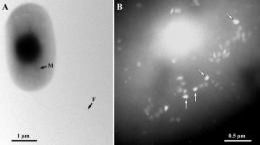Magnetic Bacteria Strain Could Pave Way for Novel Nanotech Application: Study

An international team of scientists has discovered a new type of magnetic bacteria that has the potential to pave the way for novel biotech and nanotech applications.
Sluicing through every possible water body, lead microbiologist Dennis Bazylinski and colleagues at the University of Nevada Las Vegas (UNLV) and co-researcher Christopher Lefèvre have documented the presence of a magnetic, sulfate-breathing strain of bacteria.
The researchers succeeded in culturing a bacterial strain that uses a magnetic sulfide compound to swim towards food. The researchers mined their bacterial strain along the Badwater basin located on the edge of Death Valley National Park, Nevada, also otherwise known as the Silver State, and a haven for precious metals.
Richard Frankel, co-researcher and professor emeritus, worked with microbiologist Dennis Bazylinski of the University of Nevada, Las Vegas, and other scientists on the project. The group's findings were published in the current issue of Science Magazine.
The new discovery is likely to encourage further understanding of how bacteria can make minerals which could prove significant for advances in biotechnology and nanotechnology.
Previously found magnetite bacterial strain has shown presence of magnetic crystals, called magnetosomes that are useful in drug delivery and medical imaging. However, the discovery of the new magnetic strain is seen as a step forward.
The new research is a successful attempt at understanding how to grow the bacterium in the laboratory, opening up avenues to understand how it works, and potentially utilize the impact of these in either manufacturing or environmental cleanup.
The research group identified, isolated and cultivated an unusual strain of magnetotactic bacteria. These are single-celled organisms found in almost all bodies of water.
Frankel explained that the name magnetotactic suggests that these bacteria can swim toward one pole of a bar magnet and away from the other like a swarm of microscopic compass needles. In fact, these actually swim parallel to the Earth's magnetic field.
This magnetic property is attributed to the nano-sized crystals of the minerals magnetite or greigite they produce.
The paper noted that the bacteria with magnetotactic ability, included several groups of bacteria of different shapes and sizes. While some of these were large multi-cellular bacterial groups, others are single-celled large and rod-shaped.
They contained different forms of the internal magnetic nanoparticles as well; some of the nanoparticles were made up of magnetite (Fe3O4 - iron and oxygen complex) and some made up of greigite (Fe3S4 - iron and sulfur complex). The greigite nanoparticles were a range of different shapes while the magnetite crystals formed bullet shaped particles.
The new study is considered a feat because Bazylinski and his team were the first to cultivate greigite-producing species. Greigite is an iron sulfide mineral, the equivalent of the iron oxide magnetite.
Because greigite-producing bacteria have never been isolated, the crystals haven't been tested for the types of biomedical and other applications that currently use magnetite, said Bazylinski.
Greigite is an iron sulfide that may be superior to magnetite in some applications due to its slightly different physical and magnetic properties. Now we have the opportunity to find out.
Researchers found the greigite-producing bacterium, called BW-1, in water samples collected more than 280 feet below sea level in Badwater Basin. Lefèvre and Bazylinski later isolated and grew it leading to the discovery that BW-1 produces both greigite and magnetite.
A detailed look at its DNA revealed that BW-1 has two sets of magnetosome genes, unlike other such bacteria, which produce only one mineral and have only one set of magnetosome genes.
According to Bazylinski, the greigite-producing bacteria represent a new, previously unrecognized group of sulfate-reducing bacteria that breathe the compound sulfate rather than oxygen as most living organisms do.
With how much is known about sulfate-reducing bacteria, it's surprising that no one has described this group, he said.
The finding is significant in showing that this bacterium has specific genes to synthesize magnetite and greigite, and that the proportion of these magnetosomes varies with the chemistry of the environment, said Enriqueta Barrera, program director in the U.S. National Science Foundation's (NSF) Division of Earth Sciences.
The research was funded by the U.S. NSF, the U.S. Department of Energy and the French Foundation for Medical Research.
© Copyright IBTimes 2024. All rights reserved.





















